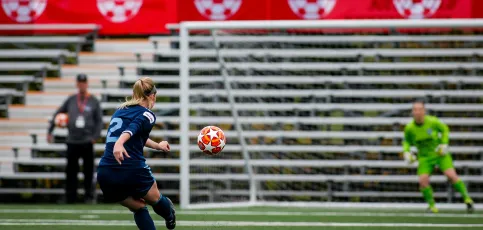
Seismic site characterization in terms of shear wave velocity (VS) distribution with depth is a fundamental aspect of engineering design in seismically active areas. Soil deposits in Iceland largely consist of coarse-grained basaltic granular materials (i.e., coarse silt, sand, gravel, and coarser grains), although thick peat deposits exist in some locations. Complicating the soil site characteristics, in many areas, the granular sediments are overlaid by Holocene lava formations, creating layers of fractured lava-rock on top of or embedded in softer sediments. These result in strong stiffness reversals with depth.
Various methods exist for evaluation of in-situ VS profiles, including active- and passive-source surface wave analysis methods (SWMs). Research on the application and adaptation of advanced SWMs for Icelandic soil site conditions has been ongoing for the better part of a decade. Initial steps were taken during the doctoral study of Elín Ásta Ólafsdóttir, who graduated with a Ph.D. from the Faculty of Civil and Environmental Engineering, University of Iceland in 2019. The research continued as part of the IRF-funded projects Geotechnical seismic site characterization and local site response studies in South Iceland [Postdoctoral Fellowship Grant] and Seismic Risk in Iceland [Grant of Excellence] and projects supported by the Icelandic Road and Coastal Administration (Vegagerðin) and the National Power Company of Iceland (Landsvirkjun). Methods for dispersion analysis, inversion and uncertainty assessments have been proposed and verified by measurements at geotechnical benchmarking sites in Norway (Norwegian GeoTest Sites). That work has further resulted in the development of open-source software for acquiring and analyzing active-source SWM data (MASWaves and MASWavesPy).
The application of SWMs is time and cost efficient and the data acquisition is conducted on the surface, neither requiring heavy machinery nor leaving lasting marks at the site (non-invasive surveying), thus, minimizing environmental effects. Active-source SWMs have been found well-suited for profiling a wide variety of local soil sites. This includes gravelly sites and sites characterized by partly cemented volcanic soil materials and mixed soils containing cobles and boulders, where the use of traditional penetration methods has proven difficult (or impossible). More recently, the investigation approach was extended to include a joint analysis of actively and passively generated surface waves to retrieve soil VS, fundamental site frequency and depth to bedrock at deep soil sites (depth to bedrock 100-200 m). The joint analysis has further been found effective to characterize sites where a layer of fractured lava-rock is sandwiched between softer sediment layers. The potential for SWMs to characterize soil sites with embedded layers of lava rock at shallow depth is essential for subsequent numerical ground response analysis to study the effects of the granular sediments, underlying the lava-rock, on ground motion amplifications for expected seismic hazard scenarios in Iceland.
As measured VS profiles have a great practical value for seismic-resistant geotechnical engineering design, an open database (serice.hi.is) has been constructed where, to date, data and interpreted results of active-source SWMs conducted in 19 areas in Iceland can be accessed and compared. Together, the tested sites represent the three most encountered types of natural soil deposits in Iceland, in addition to engineered fills. The VS profiles are further presented as time-averaged shear wave velocity (VS,z), in line with the site categorization in the current Eurocode 8 (EC8). Empirical correlations, describing the relationship between the effective confining pressure and in-situ small-strain shear stiffness, have further been developed for each class. Such correlations can be used to evaluate stiffness parameters for the specific soil types in absence of site-specific measurements, and to extrapolate measured profiles down to a greater depth. Future work is aimed at extending the database by adding results from measurements conducted in more locations in Iceland, as well as information on key site effect proxies. Coming surveying efforts are also aimed at assessing the depth of the seismic bedrock formation and/or the fundamental frequency of the soil deposits required for standard site categorization according to the 2nd generation EC8. Future research in this field is believed to be of great value for professional engineers in Iceland to implement the new site classification scheme and aid simplified identification of site categories in cases where little (or no) quantitative information is available.
The figure shows a typical configuration of the measurement equipment that is used for active-source surface wave measurements.


